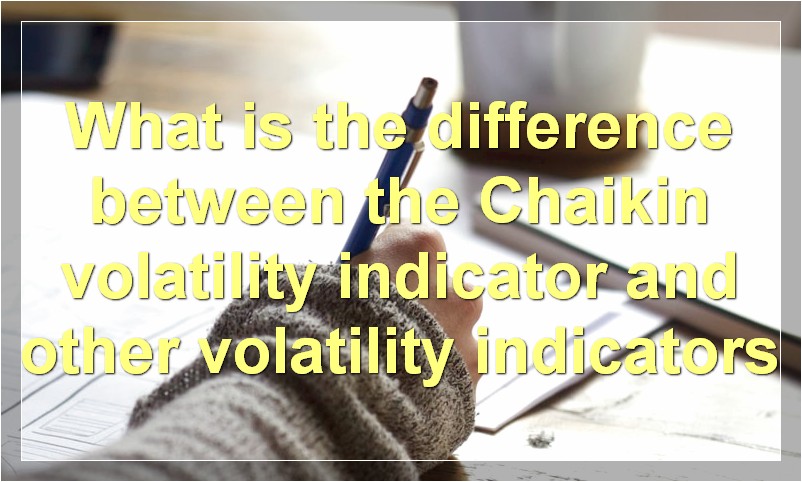If you’re looking to get an edge on the market, then you need to know about the Chaikin volatility indicator. This powerful tool can help you make informed decisions about when to buy and sell, and it’s easy to use once you know the basics. In this article, we’ll give you everything you need to know about the Chaikin volatility indicator so that you can start using it to your advantage.
What is the Chaikin volatility indicator

The Chaikin volatility indicator is a technical analysis tool that measures the difference between the high and low prices of a security over a given period of time. The indicator is used to gauge market momentum and identify potential reversals.
The Chaikin volatility indicator is named after its creator, Marc Chaikin. Chaikin was a Wall Street trader who developed the indicator in the 1970s.
The indicator is calculated using the following formula:
Chaikin Volatility = ((Highest High – Lowest Low) / (Highest High + Lowest Low)) * 100
The resulting number is plotted as a line on a chart. A rising line indicates increasing market volatility, while a falling line indicates decreasing market volatility.
The Chaikin volatility indicator can be used to identify potential turning points in the market. A sudden increase in volatility may signal that a trend is about to reverse. Similarly, a sudden decrease in volatility may signal that a consolidation period is coming to an end.
How is the Chaikin volatility indicator used
The Chaikin volatility indicator is used to help traders identify periods of high and low volatility in the markets. This can be helpful in making trading decisions, as it can allow traders to better time their entries and exits. The indicator is calculated using the standard deviation of the high and low prices over a given period of time. A period of high volatility is typically associated with a wider range of prices, while a period of low volatility is typically associated with a narrower range of prices.
What are the limitations of the Chaikin volatility indicator
The Chaikin volatility indicator is a popular tool used by traders to measure market volatility. However, the indicator has several limitations that traders should be aware of.
One limitation of the Chaikin volatility indicator is that it is based on historical data, which means that it cannot predict future market movements. Another limitation is that the indicator is only suitable for use on liquid markets, as it can produce false signals on illiquid markets. Finally, the indicator is only effective at identifying short-term market volatility, so it may not be useful for long-term trading strategies.
How can the Chaikin volatility indicator be improved
The Chaikin volatility indicator is a technical analysis tool that measures the amount of price change over a given period of time. The indicator can be used to identify market trends and potential reversals.
There are a few ways to improve the Chaikin volatility indicator. One way is to use it in conjunction with other technical indicators. For example, the indicator could be used with support and resistance levels to help confirm price direction.
Another way to improve the Chaikin volatility indicator is to use different timeframes. For example, using a longer timeframe will smooth out the indicator and make it less susceptible to false signals. Conversely, using a shorter timeframe will make the indicator more sensitive and increase the chances of catching a trend early.
Finally, another way to improve the Chaikin volatility indicator is to use different settings. For example, changing the length of time used to calculate the indicator can help fine-tune its accuracy.
What is the difference between the Chaikin volatility indicator and other volatility indicators

Chaikin volatility indicator is a technical analysis tool that measures the difference between the high and low prices of a security over a given period of time. It is used to gauge market volatility and is often compared to other indicators, such as the Bollinger bands.
The Chaikin volatility indicator is unique in that it uses the relationship between the security’s price and its moving average to calculate market volatility. This makes it different from other indicators, which only take into account the security’s price.
The Chaikin volatility indicator is a useful tool for traders who want to get an idea of how volatile the market is. It can help them make better decisions about when to enter and exit trades.
What are some other uses for the Chaikin volatility indicator
The Chaikin volatility indicator is a technical analysis tool that measures the rate of change in a security’s price.
One use for the Chaikin volatility indicator is to help identify potential breakouts. A breakout is when the price of a security moves outside of a defined range. This move can signal that the security is about to make a major move.
Another use for the Chaikin volatility indicator is to help identify potential reversals. A reversal is when the price of a security changes direction. This move can signal that the security is about to make a major move in the opposite direction.
The Chaikin volatility indicator can also be used to help confirm other technical indicators. For example, if the Chaikin volatility indicator is moving in the same direction as the MACD indicator, this could be a sign that the trend is strong.
The Chaikin volatility indicator can be used in conjunction with other technical indicators and market data to help make informed trading decisions.
What are some ways to interpret the Chaikin volatility indicator
One way to interpret the Chaikin volatility indicator is to look at how it changes over time. If the indicator is rising, it means that there is more volatility in the market, and if it is falling, it means that there is less volatility. Another way to interpret the indicator is to look at the level of the indicator. A high level indicates a high degree of volatility, while a low level indicates a low degree of volatility.
What are some common mistakes traders make when using the Chaikin volatility indicator
There are a few common mistakes that traders make when using the Chaikin volatility indicator. One mistake is using the indicator to predict future volatility instead of using it as a measure of current market conditions. Another mistake is not accounting for the differences between implied and historical volatility. Finally, some traders use the indicator without fully understanding how it works, which can lead to making suboptimal trading decisions.
What are some tips for using the Chaikin volatility indicator
Chaikin volatility indicator is a handy tool that measures the market’s volatility. It is based on the principle of price and volume relationship. When the market is volatile, the prices move up and down rapidly, and the volume also increases. Thus, by comparing the price and volume data, one can get an idea about the market’s volatility.
Some tips for using the Chaikin volatility indicator are as follows:
– Look for spikes in the indicator. A spike indicates a sudden increase in market volatility.
– Compare the indicator with other volatility measures to get a better picture of market conditions.
– Use the indicator to identify potential turning points in the market.

